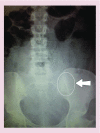Medical management of heavy menstrual bleeding
- PMID: 26695687
- PMCID: PMC4728737
- DOI: 10.2217/whe.15.100
Medical management of heavy menstrual bleeding
Abstract
Women with benign heavy menstrual bleeding have the choice of a number of medical treatment options to reduce their blood loss and improve quality of life. The role of the clinician is to provide information to facilitate women in making an appropriate choice. Unfortunately, many options can be associated with hormonal side effects, prevention of fertility and lack of efficacy, leading to discontinuation and progression to surgical interventions. Herein, we discuss the various options currently available to women, including antifibrinolytics, nonsteroidal anti-inflammatory preparations, oral contraceptive pills and oral, injectable and intrauterine progestogens. In addition, we describe the more novel option of selective progesterone receptor modulators and their current benefits and limitations.
Keywords: SPRM; adenomyosis; endometrial; endometrium; estradiol; fibroid; menorrhagia; menstruation; polyps; progesterone.
Conflict of interest statement
Financial & competing interests disclosure HOD Critchley has received collaborative Research Grant Support for research staff and consumables in context of AUB treatment from TAP Pharmaceuticals and Bayer Pharma AG; and provided Consultancy/Advisory Board contributions on AUB Treatment (Bayer Pharma AG, Preglem/Gedeon-Richter, Vifor Pharma). HOD Critchley and JA Maybin have received research grant support from the Medical Research Council (G1002033 (HODC, JAM), MR/J003611/1 (HODC) and The Wellcome Trust (100646/Z/12/Z [JAM]). The authors have no other relevant affiliations or financial involvement with any organization or entity with a financial interest in or financial conflict with the subject matter or materials discussed in the manuscript apart from those disclosed. No writing assistance was utilized in the production of this manuscript.
Figures




References
-
- RCOG. Abdominal Hysterectomy for Benign Conditions. 2009. www.rcog.org.uk/globalassets/documents/guidelines/consent-advice/ca4-150...
-
- Munro MG, Critchley HO, Broder MS, Fraser IS. FIGO classification system (PALM-COEIN) for causes of abnormal uterine bleeding in nongravid women of reproductive age. Int. J. Gynaecol. Obstet. 2011;113(1):3–13. - PubMed
-
- Hartz AJ, Barboriak PN, Wong A, Katayama KP, Rimm AA. The association of obesity with infertility and related menstural abnormalities in women. Int. J. Obes. 1979;3(1):57–73. - PubMed
-
- Rowland AS, Baird DD, Long S, et al. Influence of medical conditions and lifestyle factors on the menstrual cycle. Epidemiology. 2002;13(6):668–674. - PubMed
-
- Critchley HO, Duncan WC, Brito-Mutunayagam S, Reynolds RM. Obesity and menstrual disorders. In: Mahmood TA, Arulkumaran S, editors. Obesity: A Ticking Time Bomb for Fertility (Elsevier Insights) Elsevier; Oxford, UK: 2013. pp. 525–535.
Publication types
MeSH terms
Substances
Grants and funding
LinkOut - more resources
Full Text Sources
Other Literature Sources
Medical
Research Materials

